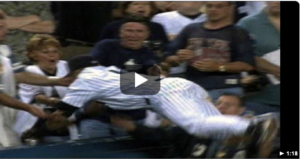There’s a lot of construction going on around our neighborhood, and most of it I’d be happy to do without. Apart from the noise (pile driving, anyone?), the end products are indistinct glassy vertical slab apartment buildings. But, our little stretch of Dearborn remains unchanged, Sandmeyer’s Book Store is still here, we can still walk to the lake, to museums, the Art Institute, and I can still get to White Sox Park in about 15 minutes on the Red Line.
Which Beth and I did twice last week. I still pinch myself; from Champaign-Urbana, and even when we were in suburban Geneva, going to the ball game was a trek that required a lot of time and advance planning.
Now, I can get home from work, check the schedule, and then decide to have my dinner at the ballpark. Sometimes I go alone, affording Beth some alone time, and I just roam the park and try out seats and listen the chatter.
The White Sox play second fiddle in Chicago, and really, that’s mostly OK. There are always tickets available, and they’re affordable. Yesterday, we had nice seats in the right field corner–$15 each.
Of course, some of the ticket availability has been due to the White Sox being bad at baseball the last few years. Being bad intentionally—long enough to pile up high draft picks and trading decent players for more young prospects—has become a thing in Major League Baseball. It’s called tanking. The Houston Astros and Chicago Cubs have done it and found ultimate success, but there is absolutely no guarantee that it works. The White Sox traded off their best players three years ago, and we fans are just now seeing at least some progress.
I’m grinning and bearing it, but I don’t much like it. Tanking is an economic/management trend that to some extent is encouraged by the current labor agreement between the players and the owners. One that fans hope is remedied during the next bargaining round.
Baseball is also making changes to make the games shorter. To that end, last year MLB limited the number of times a manager or catcher could walk to the pitcher’s mound to confer. Yesterday our friends who attended the game with us asked what the letters MVR meant on the scoreboard. Well, having had to ask that myself earlier this year, I knew that it stands for Mound Visits Remaining.
There are other changes related to game pace and length that are percolating. One proposal unrelated to the time of game is the prospect of extending the protective netting that has always wrapped around home plate all the way down each line to the right- and left-field foul poles. The issue became hot this past week because a Cubs player, Albert Almora, Jr., hit a line drive foul ball, which in turn hit a little girl.
It was a scary incident that shook Almora so much that he ended up leaving the game. There is now a growing consensus that the netting should be extended. That’s how it is in Japan, and having taken in a couple games there, I can say that though I got used to it, it was a little distracting.
Now, I’m not against protecting fans, but I do think there hasn’t been any mention of the trade-off for the added safety. Remember Derek Jeter’s insane dive into the stands to catch a foul ball? Juan Uribe’s catch in game 4 of the 2005 World Series? Or the countless acrobatic snatches the Cubs’ Anthony Rizzo has made—standing on the tarp in some cases?
Those will be gone. And sitting there in harm’s way yesterday, I personally wouldn’t make that trade off.
But, no one is probably going to ask me.
And I’ll still head to the ballpark on a whim, and maybe in a year or two, the tickets will be harder to get.

Leave a Response